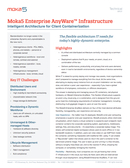Enterprise AnyWare Infrastructure
Infrastructure that’s not an infrastructure!
Moka5 Enterprise AnyWare™ is the only enterprise secure container solution designed from the ground up to handle today’s dynamic, heterogeneous, and mobile end user computing landscape. Rather than trying to manage and secure the multiplicity of physical endpoints – Moka5 delivers enterprise workspaces via secure containers that enable IT to centrally manage critical data and applications across PCs and mobile devices from a single console.
Whether deployed in the cloud, in the data center, or a combination of the two, Moka5 Enterprise AnyWare requires only a single standard dual core Intel server to run over 14,000 containers simultaneously. This highly flexible, lightweight architecture makes it easy to put the containers where the people are for significant cost reductions and productivity enhancements due to increased end-user self-sufficiency.
And because the Moka5 container is local to the endpoint, there are no backend storage requirements.
Infrastructure Components
The light-weight, scalable Enterprise AnyWare architecture that sits under all Moka5 products includes:
M5 Console – a web-based console for IT to set container policies, configure LDAP integration and create local users and groups as needed, deploy and manage images, and create reports.
M5 Management Server – the management component that is installed on a server, which allows you to manage LivePC images, and requires a small SQL server installation.
Active Directory Extender - enables enterprises to host Moka5 infrastructure in the cloud, while still leveraging existing on-premises Active Directory deployment.
M5 Mobile Gateway – this unique architecture component enables communication between the management server and Moka5 containers over the Internet for authentication, policy updates, container updates, and Windows image updates.
Multi-Tenancy – efficiently manage multiple organizations within a single deployment with automation of new tenant creation and configuration via REST APIs.
For a discussion on different deployment options – on-premises, in the cloud, or a combination of both — please contact us.

